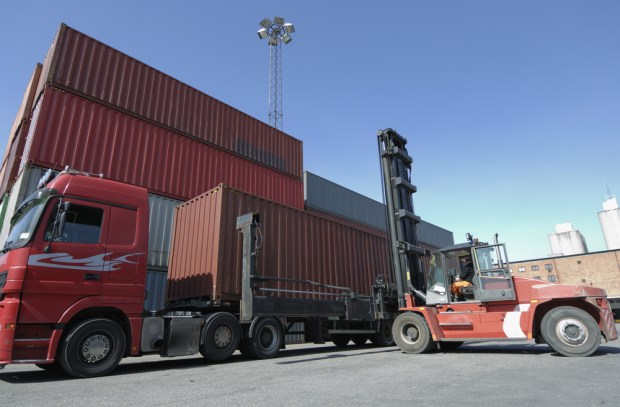For X-Border Commerce, Breaking Old Mindsets May Lower Costs

Global commerce is poised for big-time expansion over the next few years, ushering in new linguistic and technological solutions. The December edition of PYMNTS’ X-Border Tracker™ includes an interview with Kyle Plummer, director of cross-border solutions for Magnate Worldwide, who discusses how logistics services providers can help companies cut costs by pushing for a more flexible attitude. Plus, our directory of 126 global payments service providers in the X-Border Payments landscape inside the Tracker.
With the holidays on the immediate horizon, consumers are hitting shopping malls and websites to check items off their shopping lists. But over the course of the year, manufacturers were already spending billions of dollars to get the supplies on their own wish lists purchased and delivered promptly.
Ground transportation options are responsible for the moving of the bulk of goods between Mexico and the U.S., according to the U.S. Department of Transportation’s Bureau of Transportation Statistics (BTS).
In September this year alone, trucks and rail were responsible for carrying about 80 percent of all freight between the U.S. and both of its NAFTA partners, Mexico and Canada, according to BTS. Trucks were responsible for carrying $59 billion worth of both imports and exports that month. Rail was the second most utilized mode of transportation for moving freight, carrying imports and exports valued at $15 billion across the nations’ borders.
With goods valued at billions of dollars on the line, moving freight smoothly across borders can be a tall order. So, what does it take to make it happen? To answer that, PYMNTS spoke with Kyle Plummer, director of cross-border solutions for Magnate Worldwide (MWW), a logistics solutions provider that handles shipping needs for several North American companies.
“Typically, we’re moving either aerospace, automotive [or] different type of manufacturing components into and out of Mexico,” said Plummer.
One of the biggest challenges he faces is the line of communication between the Mexico-based supplier and the U.S.-based original equipment manufacturers (OEMs). That’s where MWW’s services come into play.
“We provide [clients] with the transparency to be able to see when the freight is going to be picked up from the supplier, how the customs transaction is going to take place and then a seamless transition from Mexico to the United States so they can plan their production accordingly,” said Plummer.
Changing mindsets to lower costs
Beyond providing transparency for MWW’s clients, Plummer said the company also plays a role in helping manufacturers stay on top of production plans.
“We’re taking a look at them — in some cases, what their build rates are and maybe optimizing their supply chain where traditional means have just been the norm,” said Plummer.
“They’re moving high volumes of freight, and then, when there’s a problem, they’re paying an exorbitant amount of money to get it on a chartered aircraft,” he continued.
But this attitude can be costly for the client. Using more adaptable solutions could help companies overcome unexpected obstacles.
“From a manufacturing standpoint, one of the biggest challenges is [companies’] lack of flexibility,” he said. “Manufacturers — and, even to some point, consumers … It takes them a long time to think outside the box.”
Like anyone who has ever waited until the last minute to make a purchase, Plummer said manufacturers will pay whatever price is necessary to get the items they need. Companies that are better prepared to be flexible with logistics strategy stand a better chance of getting their deliveries faster and navigating a “rigid” cross-border infrastructure.
Companies that aren’t able to think creatively risk missing out on more effective solutions, said Plummer. He encourages OEMs to consider their “true needs” and not wind up beholden to how competitors across the market are behaving simply because that’s been the pattern all along.
“That’s the challenge is breaking that mindset,” said Plummer. “You can get your material quicker. You can get it in a more cost-efficient way. You just have to be more flexible from your thought process, and I think that’s the biggest challenge.”
What’s the key to breaking that mindset? Plummer recommends putting small portions of a company’s supply chain that the business is “moderately dependent on” through beta tests that can demonstrate where any potential opportunities for improvement may be found.
“My suggestion would be take a look at the other avenues out there,” he said. “Take a look at using different bridges, different brokers, different sizes of brokers so [companies] can move more efficiently and more effectively.”
A bright spot in the logistics market during economic uncertainty
Plummer has been in the logistics industry since he began his career as a driver for FedEx Ground while he was a student in college. After college, he worked for an expediting company for eight years.
During his time in logistics, Plummer has seen the market endure many ups and downs. One of the most recent downs was during the 2008 financial downturn. Like many other industries, Plummer said the logistics sector was hit badly by the Great Recession, as well as the auto bailout that occurred the following year.
“It was a tough time for a lot of companies,” he said. “With General Motors restructuring and different companies restructuring, it was tough to be in logistics during that time.”
But while the domestic market was taking a hit, Plummer noticed a bright spot in the market during that same period of economic uncertainty.
“The only thing that was really stable, I would say, was the cross-border piece,” said Plummer.
Plummer credited moves by Mexico in the late 1990s to incentivize its market and attract suppliers from the U.S., Europe and Asia. These decisions helped get supplier goods into the U.S. in a shorter timeframe, which ultimately helped boost the logistics market during an otherwise uncertain financial period.
“The cross-border piece was still very stable, very vibrant because of the amount of manufactured goods coming out of Mexico,” he added.
The future of cross-border trade
Trade was a major theme of the 2016 presidential campaign. While it’s uncertain how the incoming administration will perform, Plummer is optimistic about the emphasis on investing in manufacturing jobs and what the decision could mean for logistic solutions providers like MWW.
“If you’re going to be putting people back to work in manufacturing or move goods between plants or to final assembly or OEMs, it takes logistics,” said Plummer. “For us in the logistics industry, especially those of us in the traditional over-the-ground trucking industry, that should be something that could build excitement for them.”
Ultimately, he hopes to see cooperation between the U.S. and Mexico increase to see more commerce performed between the two nations. He believes a strong trade relationship between the neighboring countries can lead to more cooperation and transparency for the logistics market, which can ultimately lead to higher-quality products and lower costs.
“Our fear is that, if we don’t see some of the changes, especially with the manufacturing space in the United States, that it will just continue to be the same market it’s been for the last two or three years, where it’s been kind of a flat economy,” said Plummer.
“We want to see jobs grow in the United States, and we want to see manufactured goods moving cross-border or even domestically,” he continued. “We want to see these things happen, and I don’t think there’s anyone in the logistics field who wants to see less manufacturing in North America.”
TO DOWNLOAD THE DECEMBER EDITION OF THE PYMNTS X-BORDER PAYMENTS OPTIMIZATION TRACKER™, CLICK THE BUTTON BELOW.
ABOUT THE TRACKER
The PYMNTS X-Border Payments Optimization Tracker™ is the framework for evaluating players in the cross-border payments landscape, and the quarterly index tests the readiness of the companies to serve a global audience.

